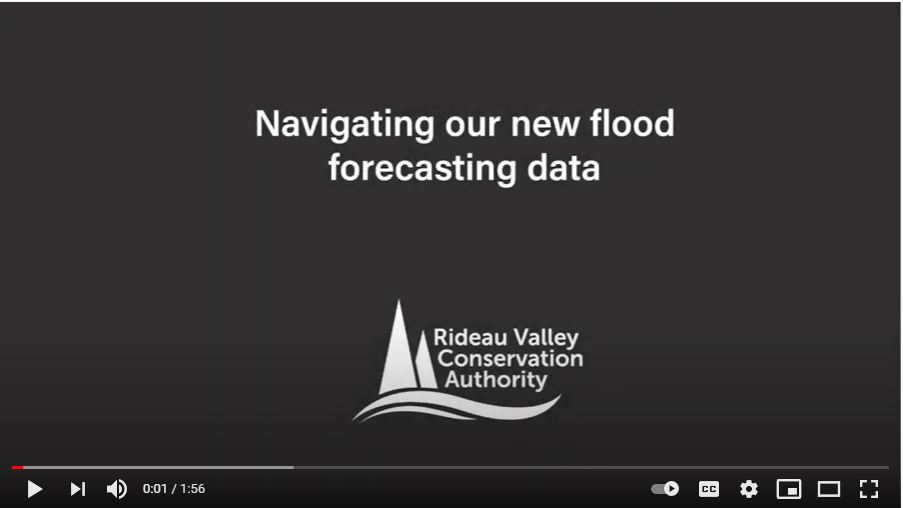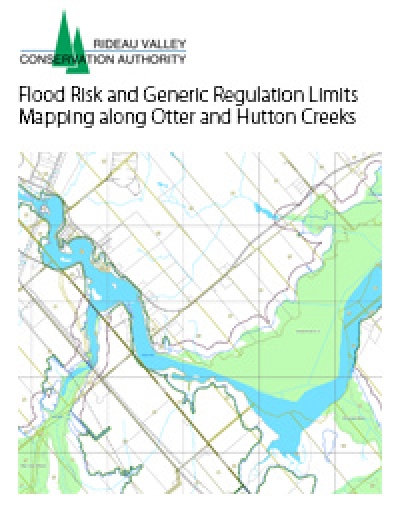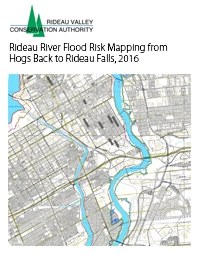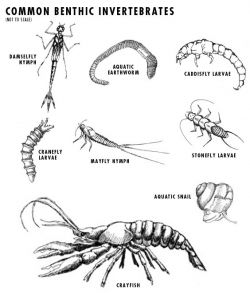
Monitoring & Reporting (91)
Children categories

Flood Risk/Hazard Mapping Reports (61)
Learn More:
- Contact Tyler Bauman, Water Resources Engineer (Flood Management)
In cooperation with local municipalities and the province, the RVCA identifies, studies and maps natural hazard areas along local rivers, lakes, streams and wetlands. Natural hazard areas include floodplains, unstable slopes. Natural features such as wetlands are also mapped. In the past, these maps were called flood risk maps.
If not understood or dealt with effectively, these hazards can pose risks and problems to society, especially when considering development activities.
Hazard mapping is used by watershed municipalities when updating Official Plan and Zoning Schedules and in the review of development applications under the Planning Act. The RVCA uses the mapping for the administration and enforcement of regulations made under the Conservation Authorities Act (Section 28).
Kemptville Creek Flood Risk Mapping - Floodplain Delineation Revision 3 (June 3, 2011)
Kemptville Creek Flood Risk Mapping - Floodplain Delineation Revision 2 (June 3, 2011)
Kemptville Creek Flood Risk Mapping - Floodplain Delineation Revision 1 (June 3, 2011)
Access water chemistry results by searching your area of interest or zooming into an area and selecting a sampling site.
Learn More:
- Current Water Conditions Statements (flood or drought)
- Contact Brian Stratton, Manager Engineering Services
Streamflow and water level data are used to monitor flood and drought events. They are also used to monitor water supply for lake operation and navigation. This information is used to determine flood risk, support land use planning, assess fish habitat and for water quality analyses of contaminant loading.
DISCLAIMER: Users of the RVCA flow data and water level data are cautioned to consider the unverified nature of the information before using it for decisions that concern personal or public safety or the conduct of business. The Rideau Valley Conservation Authority assumes no responsibility for the correctness of the information contained in this website nor liability to any user of such information, regardless of the purpose. River Levels and flows can change rapidly.
Otter and Hutton Creeks - Flood Risk and Generic Regulation Limits Mapping Along Otter and Hutton Creeks, 2016
Rideau River Flood Risk Mapping from Hogs Back to Rideau Falls, 2016
Current Water Conditions Statements
(flooding or drought conditions)
Water plays a central role in all activities within a watershed. The rain that falls on the ground flows to the river and sustains all forms of life. All physical and biological activities within a watershed are intimately connected to water. Therefore, the knowledge of its occurrence, distribution, movement and functions is indispensable in understanding a watershed and all the living beings therein.
Within the Rideau Valley, water levels and stream flow, precipitation and snowpack have been systematically recorded for many years.This information can be analyzed to understand various aspects of the water cycle (or hydrologic cycle) and their impacts on the watershed. Monitoring streamflow and precipitation allows water managers to identify risk-prone areas and better respond to drought or flood conditions.
The RVCA has gathered information on surface water quality since the early 1970s. Today, the RVCA collects data four water quality monitoring programs:
- Provincial Water Quality Monitoring Network (Water Chemistry)
- RVCA Baseline Monitoring Program (Water Chemistry)
- Watershed Watch (Water Chemistry)
- Benthic Invertebrate Sampling (Water Biology)
Results from these monitoring programs are reviewed and reported on through our catchment and subwatershed reports.
More...
Groundwater has only recently been recognized as a vital natural resource. Ground water is an important source of drinking water for many in the Rideau watershed. Contamination of local groundwater is a growing concern and groundwater flow in bedrock aquifers has only recently started to be characterized (theory, methods, tools and models specific to fractured rock aquifers). Groundwater as a “science” is still young.
Since 2005, RVCA has been coordinating the Source Protection Program for the Mississippi-Rideau Source Protection Region (MRSPR). This work has involved undertaking a number of technical studies and the development of source protection plan policies for the MRSPR to protect shared municipal drinking water sources within our watersheds. Additional information about the local source protection program is available here: mrsourcewater.ca
Currently, the groundwater program at RVCA is small and primarily focuses on being a source of expertise for municipal planning services related to rural drinking water. The program also provides support to development applications near wetlands and groundwater recharge and discharge areas.
RVCA looks to learn more about our groundwater resources and their specific roles in the local hydrological cycle. We monitor and gather information at 16 wells at 13 locations in the Rideau Valley as part of the Ministry of the Environment and Climate Change’s (MOECC) Provincial Groundwater Monitoring Network (PGMN). The main goal of the PGMN program is to undertake long-term regional groundwater monitoring in order to be able to identify potential changes in groundwater quality or levels. RVCA also partners with provincial agencies, local municipalities and academia for special projects related to groundwater information management, subwatershed studies and groundwater surface water interactions.
The streams and rivers in the Rideau Valley watershed are home to a variety of plants and animals.
RVCA staff collect information on the physical conditions of the watershed — vegetation, wetlands, shorelines, land uses. We also look at fish communities and benthic invertebrates. We look see how aquatic and terrestrial creatures interact with their environment. All this information is used to create a picture of the conditions of our streams, lakes, rivers and overall watershed. In turn, this information will set the management direction for the future.
Information is compiled and summarized in RVCA catchment reports and subwatershed reports.
The RVCA collects, monitors and analyses watershed information.
Monitoring environmental conditions helps us see trends over time, focus our actions where they can do the most good, and evaluate the effectiveness of our watershed policies and programs.
Reporting information ensures the right information is available to municipal and watershed decision makers (including watershed residents).
Use the menu to the right to visit our monitoring and reporting information. You can also access information through our interactive mapping. See below for details on what is currently available.
Interactive Mapping Tool
Access information through our interactive mapping tool. Choose from these mapping options:
RVCA |
Access our robust interactive mapping with multiple tools to help you find regulation limits, flood event depths, flood & low water status, landcover, conservation areas and more. Note: as of April 1, 2024, Ontario Regulation 41/24: Prohibited Activities, Exemptions and Permits will replace the RVCA's existing Ontario Regulation 174/06 under Section 28 of the Conservation Authorities Act. Our online map tooling tool is being updated to reflect Ontario Regulation 41/24. Our online mapping tool has been updated to reflect our Interim Policy for the Administration and Implementation of Ontario Regulation 41/24. |
Streamflow, Water Levels & Weather Stations |
See real-time and periodic information from a network of sources from across the watershed. |
Water Quality - |
View water quality data collected across the watershed. See where we test and the results. |
Subwatersheds and |
Explore our subwatershed reports that highlight four indicators of watershed health: water quality, forest cover, wetland cover and riparian cover. |
Map A Property |
Search properties to see if it may be subject to RVCA Regulation - Section 28. Note: as of April 1, 2024, Ontario Regulation 41/24: Prohibited Activities, Exemptions and Permits will replace the RVCA's existing Ontario Regulation 174/06 under Section 28 of the Conservation Authorities Act. Our online map tooling tool is being updated to reflect Ontario Regulation 41/24. Watch for updates to our mapping tool as we modify our maps to reflect new wetland boundaries. Please contact us for information.
|

















